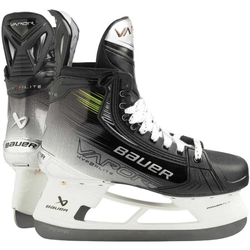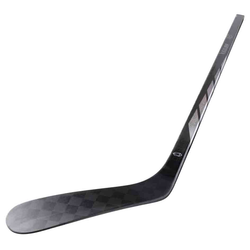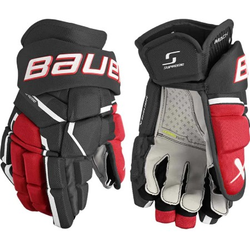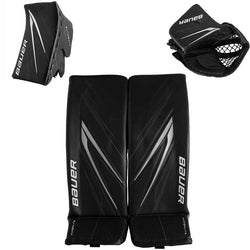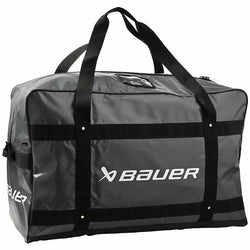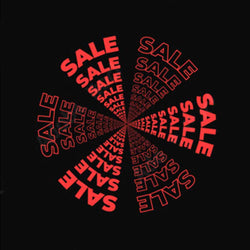Ice Hockey Guide
So, you're thinking of playing one of the most exhilarating, thrilling sports on the planet? What a fantastic idea!
Whether you're taking a leap into a new hobby at your local rink/university, or you're a parent of a child who wants to join - we're here to show you everything you need to know to start playing ice hockey.

WHY START PLAYING ICE HOCKEY?
For adults taking the plunge, strapping blades to your feet and entering the ice is an adrenaline-fuelled feeling, it will keep you fit and it's great for your mental wellbeing.
For children, not only is it fun and the perfect social activity, it will provide them with life-long skills; confidence, teamwork, communication and decision-making abilities.
WHAT ARE THE MAIN RULES AND STRUCTURE OF THE GAME?
Hockey at its core is a very simple game. You skate, you pass, you shoot and you score. Before jumping onto the ice, it's worth getting to know a few basics of the game.
OBJECTIVE
- The objective is to score more goals than the opposing team.
- A goal counts as one on the scoreboard (just like football/soccer).
PLAYERS

There are 6 players per team on the ice at one time (including the goalie).
The game allows unlimited substitutions from the bench during stoppages and play.
There are 6 different positions:
- Goalie - Their job is to prevent the ice hockey puck from entering their net.
- Defence players (left & right) - They are tasked with stopping the opposing forwards when their team does not have possession of the puck, and providing offensive support when the team does have possession.
- Forward – centre - Responsible for taking faceoffs (the way play starts and restarts after a goal) to regain possession and covering the centre of the ice at both ends of the rink.
- Forward – left & right wing - The wingers are responsible for play along the sides of the rink. They have some defensive responsibilities, but are primarily relied upon as goal scorers.
A goal can be scored by anyone on the ice, including the goalie, but this is still a rarity.
THE BASIC RULES

- Offside - Play is declared 'offside' when an attacking player enters into the offensive zone before the puck does. Both skates over the blue line would count as 'entering'.
- Icing - When a team shoots the puck from their own side of the centre red line and across the opposition's goal line. There is one exception though - when a team is short-handed due to a penalty, icing is legal.
- Faceoffs - Each play begins with a faceoff and ends when a goal is scored, or the referee blows the whistle.
PENALTIES
Penalties are how players get in trouble with their sticks and bodies. Players will serve their penalties in the penalty box (sin bin).
A minor penalty is two minutes in length. Major penalties and misconducts are for more serious offences and can be for 5 minutes, 10 minutes or a full match.
Whilst a penalty is being served, the opposing team receives a man advantage called a 'power play'. A power play lasts for the duration of the penalty. In the case of minor penalties, the power play will end early if the team with the man advantage scores a goal.
Penalties can be for stick fouls such as, high sticking, hooking and tripping.
Penalties are also for body fouls, including holding and roughing.
Here's a few penalties to avoid:
- Roughing – striking an opponent with a hand or fist.
- Hooking – obstructing progressive play by 'hooking' an opposing player with your stick.
- High sticking – playing with your stick above shoulder height or the goal cross bar.
- Tripping – using body parts or your stick to cause an opposing player to fall over.
- Interference – obstructing a player not in possession of the puck.
- Spearing – stabbing at an opponent with your stick (regardless whether this makes contact or not).
- Charging – jumping or taking over three strides to violently hit a player and separate them from the puck.
- Holding – grabbing an opponent to hold them back.
- Fighting – partaking in a physical altercation. Often when punches are thrown.
DO I ALREADY NEED TO BE ABLE TO ICE SKATE?
If you can't already skate, this shouldn't stop you taking up hockey - it's simply a hurdle to overcome.
Start by going to open ice skating sessions at a nearby rink, followed by skating lessons if you feel you need them. Our local is Ice Sheffield but they're everywhere, so check out where yours is.
Additionally, take a look at YouTube videos, for example Vinnie Langdon's: How To Hockey Ice Skate for Beginners!
WHAT SHOULD I EXPECT FROM ICE HOCKEY?
- Friendships – you'll meet plenty of new people. It's a sport known for tight team bonds.
- A proper work out – adults burn approximately 400 - 700 calories per hour of play, from the short interval bursts.
- Patience – learning to play is a complex skill which needs coaching and training. Determination, commitment and practice are the keys to success.
HOW DO I FIND A TEAM NEAR ME?
ENGLAND OR WALES
Find your local club at the English Ice Hockey Association site.
SCOTLAND
Find your local team at the Scottish Ice Hockey Association site.
IRELAND
Take a look at the Irish clubs on the Irish Ice Hockey Association site.
NORTHERN IRELAND
The Belfast Giants are in an elite league but they do have a junior, development team. Find out more.
UK UNIVERSITY
If you want to start playing at uni, find out if they have a club at the British Universities Ice Hockey Association site. You don't need to study at the university to play in their team, so take a look at nearby universities that may have a team too.
USA
Find your local team at USA Hockey.
CANADA
Find your nearest hockey league.
WHAT'S THE RIGHT EQUIPMENT?
Making sure your kit fits properly is crucial. Equipment that fits correctly is not only more protective, it is also more comfortable and allows you to perform better.
As the following items must fit you perfectly, we would recommend buying these items first:
SKATES
Having comfortable, well-fitted ice hockey skates is vital and will help you to enjoy the game. Skate brands offer different skate models that are tailor-made for your foot shape, offering the best possible fit.
The ideal fit is snug, with your foot resting flat on the foot bed. A skate that is too big won't offer the best skating stability and will impact your skating performance. A skate that is too small will feel cramped and uncomfortable with each stride.
There are two types of skates – player ice hockey skates and goalie hockey ice skates. As a rookie, a standard pair of player skates will be just fine until you've got a permanent position in a team.
HELMET
An ice hockey helmet is an absolute must for protection on the ice. Your helmet should:
- Fit snugly without constricting the head.
- Cover roughly half of the forehead to just above the brow.
- Be secure enough that the helmet does not wobble out of position.
One of the top junior helmets is the CCM Fitlite 3DS Youth Helmet, providing youth-specific protection. Take a look at its adjustment features in our guide.
Once you have a designated position, you can build up your kit depending on your position.
GOALIE:
PLAYER:

GET TO GRIPS WITH THE LINGO
Here's our A-Z of ice hockey terms so you can talk the talk as well as skate the skate:
Assist: An assist is a credit given to 1 or 2 players (other than the goal scorer), who helped to create the goal opportunity e.g. by passing.
Backchecking: The aim of backchecking is for the defending team to regain possession of the puck.
Barn: Slang for the ice rink.
Biscuit: The puck
Blueliner: Defence players
Body checking: Using body parts (shoulders to hips), to physically knock into an opposing player and separate them from the puck.
Bucket: Helmet
Butterfly: When goalies plunge to their knees in order to block the net with their leg pads.
Catcher: A glove worn by goalies so they can catch pucks heading towards them.
Clapper: Slap shot.
Cookie jar: The top of the goal net.
Crease: A semi-circle area in front of the goal. Offence players cannot enter the crease until after the puck does.
Deke [deek]: A play intended to trick an opponent into moving out of position.
Drop pass: A direct pass behind to a teammate.
Dropping gloves: Preparing for a fight.
Egg: When a game's final score is 0.
Faceoff: When the game begins, or play is re-started, the puck is dropped onto a faceoff spot on the ice. A player from each opposing team tries to win possession of the puck.
Fisticuffs: Fighting.
Five-hole: The space between a goalie's legs.
Forechecking: Defensive play occurring in the offensive zone, in order to re-possess the puck.
Gino [jee-noh]: A goal that is scored.
Grinder: A player praised for working hard on the ice and assisting with goals, rather than being a lead scorer.
Hands: A player with great stick handling.
Hat-trick: If a teammate scores 3 goals in one game. See our 'Bizarre ice hockey traditions' for fan's reactions to a hat-trick.
High-stick: A penalty for hitting a player above the shoulders with a stick.
Hit: When a body check successfully removes the puck from an opposing player.
Interference: A penalty for obstructing a player not in possession of the puck.
Jibbs: Teeth.
Laser: A powerful, precise shot.
Limoges: Own goal.
Liney: The linesmen.
Long side: The goal side that is furthest away from the player shooting.
Man on: Teammates shout this as a warning that an opposing player is nearby.
Major penalty: 5 min penalty.
Minor penalty: 2 min penalty.
Mitts: Player's hands.
Netminder: Goalie.
Neutral zone: The ice between blue lines.
Official: The referee.
Paddle: The wide section of a goalie's stick.
Pepper pot: Fast player.
Pillows: Goalie's leg pads.
Playoff beard: 'A superstition' – players not shaving any facial hair during the playoffs.
Poke checking: When an opponent pokes the puck away from the other team.
Power play: If a team has more players on the ice due to penalties.
Rebound: When someone takes a shot and the puck bounces off a player or the net.
Shadow: Following an opposing player to skew their game.
Shaft: Long part of a player's stick.
Sieve: A jeer towards the goalie if they let in too many goals.
Sin bin: Where you're sent if you're given a penalty.
Snipe: A powerful, accurate goal.
Stickhandling: Controlling the puck through the opposing team.
Stripes: Referee.
Tilly: Having a fight.
Top shelf: The upper goal area.
Trapper: The goalie's catching glove.
Twig: Hockey stick.
Waffle: The goalie's blocker.
Wrap around: A goal from behind the net.
Wheels: Ice skates.
Zebra: Referee.
Now you know the rules, lingo and you're safely kitted out, you can hit the ice and get practising.
Good luck!
Published 20 November 2018
Last Updated: 13 June 2019

